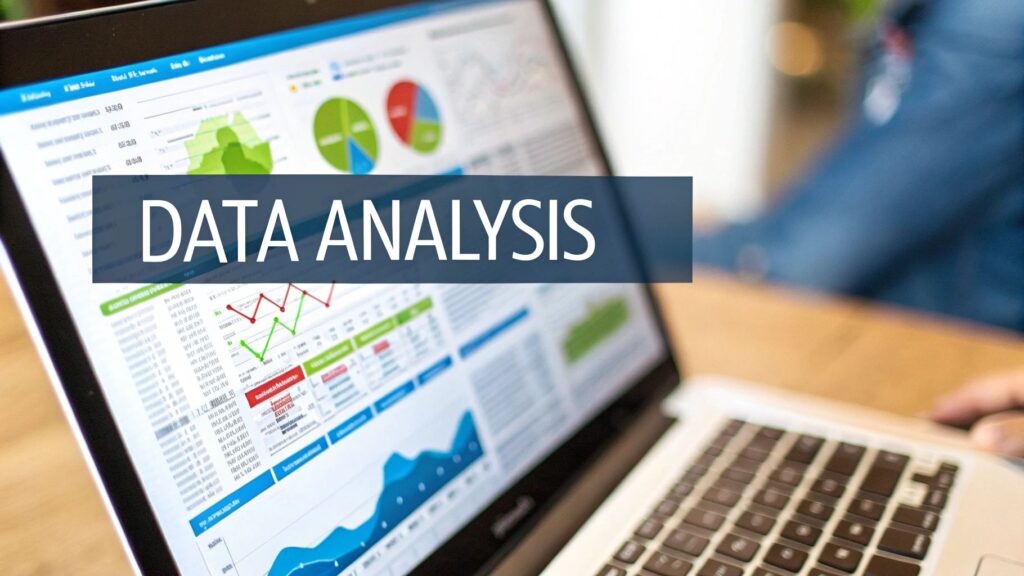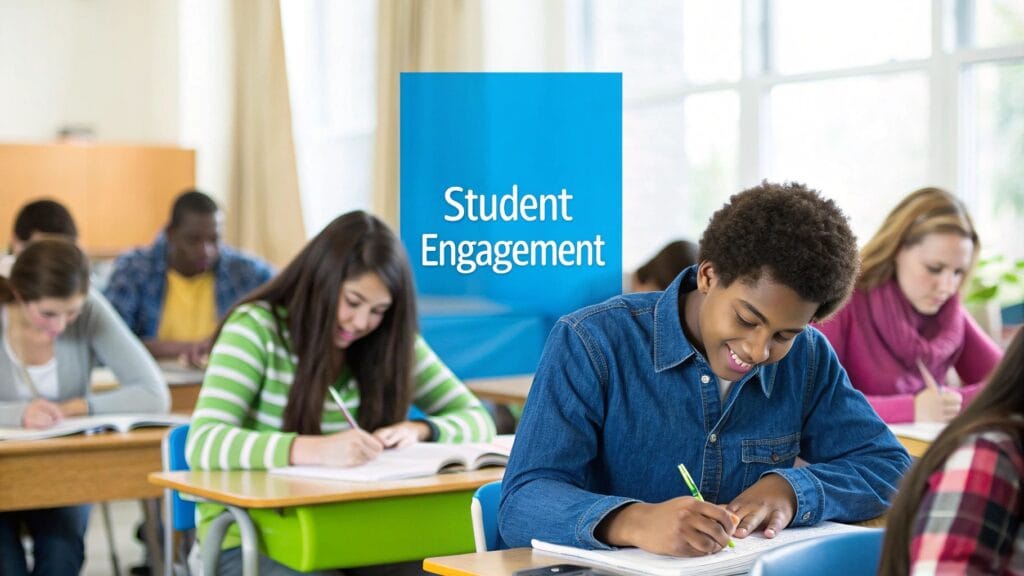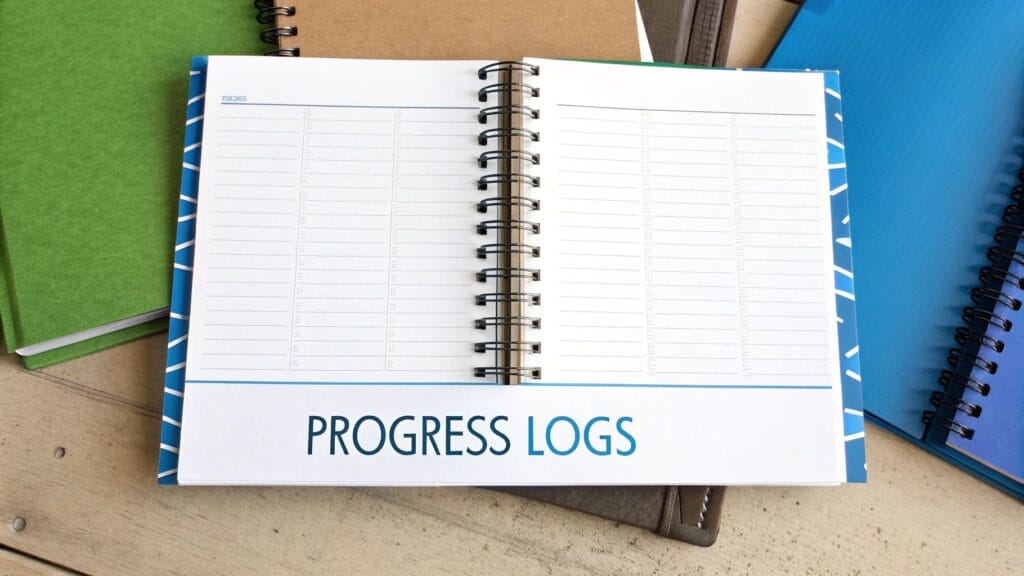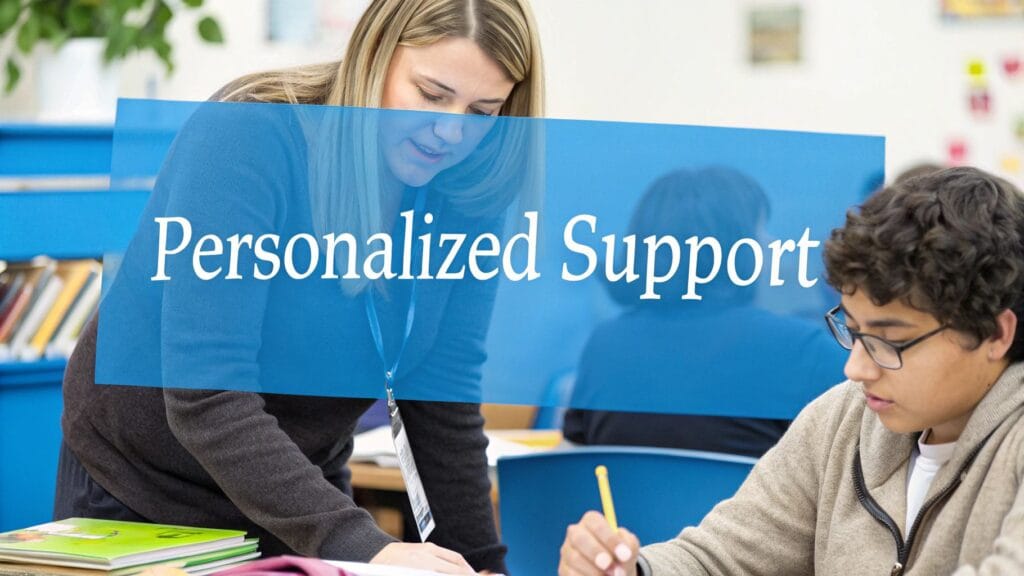Transforming Special Education Through Strategic Monitoring
Good special education progress monitoring is essential for helping students with special needs reach their full potential. When done thoughtfully, monitoring becomes much more than just checking boxes – it provides valuable insights that guide instruction and support student growth. The key is using data strategically to track progress toward each student’s Individualized Education Program (IEP) goals.
Understanding the Growing Need
The special education landscape continues to evolve as student populations change and new research emerges about effective practices. According to recent data, 7.5 million students ages 3-21 now receive special education services under IDEA, making up 15% of all public school students. View the full statistics from the National Center for Education Statistics. This significant portion of students needs carefully designed monitoring systems to ensure they receive appropriate support.
Moving Beyond Traditional Methods
Leading schools are taking a fresh approach to progress monitoring by embracing data-driven practices supported by technology. Rather than relying on time-consuming paper documentation, they use digital tools to collect comprehensive data more efficiently. This allows teachers to spend less time on paperwork and more time working directly with students to support their learning needs.
Practical Ways to Make Monitoring Meaningful
To transform monitoring from a compliance task into a valuable teaching tool, consider these key strategies:
Set Clear Goals: Work with the IEP team to create specific, measurable goals that align with each student’s needs and learning style. Goals should follow the SMART framework – specific, measurable, achievable, relevant and time-bound.
Monitor Consistently: Track progress regularly using various assessment methods. Frequent monitoring helps identify growth patterns and areas needing attention.
Use Data to Guide Decisions: Look for trends in the collected data to inform instruction. Adjust teaching strategies based on what the data reveals about student learning.
Keep Communication Open: Share updates often with parents, teachers and specialists. Regular discussions about student progress help ensure everyone works together effectively.
Making a Real Difference
When monitoring is done well, it can significantly improve student outcomes. For example, consistent progress tracking might reveal that a struggling reader needs focused work on specific decoding skills. By identifying and addressing such gaps early through targeted support, students can overcome obstacles to their learning. This proactive approach helps ensure every student receives instruction matched to their unique needs and learning pace.
Navigating Legal Requirements With Confidence

Effective progress monitoring in special education requires more than just following rules – it means understanding the legal foundations that protect students’ rights to quality education. When educators grasp both the requirements and the reasoning behind them, they can create systems that truly support student success.
Understanding the Legal Framework
The cornerstone of special education law is the Individuals with Disabilities Education Act (IDEA), which guarantees students with disabilities access to a Free Appropriate Public Education (FAPE). This means schools must provide personalized instruction and support services matched to each student’s specific needs. Regular progress monitoring generates the data needed to show these services are working.
The 2017 Endrew F. v. Douglas County School District Supreme Court case raised the bar for what constitutes appropriate education. The Court ruled that schools must provide more than minimal benefit – they must show students are making meaningful progress on their IEP goals. This decision made careful progress tracking essential for demonstrating student growth.
Practical Steps for Legal Compliance
While legal requirements may seem complex, breaking them down into concrete actions makes them manageable:
Create Clear, Measurable Goals: Write IEP goals that are specific enough to track progress objectively. Well-defined goals serve as roadmaps for both instruction and assessment.
Monitor Consistently: Set and follow a regular schedule for gathering progress data aligned with each student’s IEP. Steady monitoring helps identify both gains and areas needing extra support.
Keep Detailed Records: Maintain thorough documentation of both the progress data and any instructional changes made in response. Good records tell the complete story of a student’s educational journey.
Work as a Team: Share progress updates regularly with parents and IEP team members. Open communication ensures everyone understands how the student is doing.
Building a Robust Monitoring System
A strong progress monitoring system does more than meet legal requirements – it drives better outcomes for students. When teachers can quickly analyze trends and adjust instruction based on data, students benefit from more targeted, responsive teaching. A well-designed system also makes documentation more efficient, letting teachers focus their energy on instruction and student support.
Maximizing Impact Through Technology Integration

A well-designed special education progress monitoring system depends on selecting and implementing the right technological tools. When used thoughtfully, these tools help educators collect and analyze data more efficiently while improving communication between all stakeholders. The result is more time for what matters most – supporting students.
Streamlining Data Collection and Analysis
Digital platforms have transformed how educators track student progress and IEP goals. Instead of managing stacks of paper records, teachers can now document data, generate reports, and spot trends through centralized systems. For example, EDPlan Progress Track integrates with electronic IEP systems to automate data collection and visualize student growth over time. This helps ensure IEP compliance while reducing administrative work.
Choosing the Right Tools
When selecting technology, focus on platforms that are:
- Simple for staff to learn and use
- Compatible with current systems
- Secure and compliant with privacy regulations
- Equipped with robust reporting features
The goal is to find tools that faculty will readily adopt and that facilitate collaboration between team members. Look for options that enable secure information sharing between teachers, specialists, administrators and families.
Enhancing Collaboration and Communication
Modern progress monitoring platforms create a shared space for everyone involved in supporting students. Teachers can easily share data with specialists, administrators can review student growth, and parents can stay updated on their child’s development. Automated reporting features help streamline these communications by generating custom updates for IEP meetings and parent conferences.
Visualizing Data for Meaningful Insights
Clear data visualization helps identify patterns that might be missed in spreadsheets alone. For instance, tracking reading fluency scores through graphs can highlight both progress and plateaus. This makes it easier to have productive conversations about adjusting instruction and interventions. For more guidance on evidence-based approaches, see our article about autism interventions.
By thoughtfully implementing technology and establishing strong data practices, schools can make progress monitoring a powerful tool for supporting student success. The key is creating systems where everyone can easily access, understand, and use student data to inform decisions. When teams work together with clear insights, they can provide more targeted and effective support for each student’s unique needs.
Transforming Data into Actionable Insights
Gathering data is just the beginning of effective special education progress monitoring. The real value comes from turning raw numbers into clear insights that guide teaching decisions. This process involves carefully examining student performance, identifying patterns, and making targeted changes to support each learner’s growth.
Analyzing Progress Data
When reviewing student data, educators need to look beyond simple scores to understand what the numbers really mean. For instance, if a student consistently struggles with making inferences while reading, this signals a need for focused instruction in that specific area. Comparing current performance to baseline measurements helps teachers gauge whether their strategies are working and where adjustments may be needed.
Identifying Trends and Making Informed Decisions
Regular progress monitoring reveals important patterns in how students learn. Teachers might notice steady improvement in math skills or ongoing challenges with writing organization. These observations directly shape teaching methods. For example, consistent progress suggests current approaches are effective, while lack of improvement indicates a need for different strategies. This responsive teaching ensures instruction adapts to meet each student’s changing needs.
Progress monitoring plays a vital role in providing students with disabilities their legally mandated free and appropriate public education (FAPE). The data helps determine if specially designed instruction (SDI) is helping students achieve their IEP goals and succeed in general education. By comparing actual versus expected progress, teachers can evaluate if their methods are working. Learn more about progress monitoring in special education here.
Setting Meaningful Goals and Adjusting Instruction
Clear, well-defined goals form the foundation of effective progress monitoring. These goals should be SMART – Specific, Measurable, Achievable, Relevant, and Time-bound. Rather than a vague goal like “improve reading,” a SMART goal might state “increase reading fluency to 100 words per minute with 95% accuracy on grade-level passages by the end of the semester.” This specificity makes progress easier to track and measure.
Teachers use monitoring data to fine-tune their instruction. When progress falls behind expectations, they might implement targeted interventions like one-on-one support or small group work. For students showing strong progress, teachers can introduce more challenging material to maintain engagement. This ongoing cycle of monitoring and adjustment helps maximize each student’s learning potential.
Practical Approaches to Instructional Adjustments
Teachers have many practical options for adapting instruction based on student data:
- Modifying Instruction Methods: Adjusting lesson pacing, using different materials, or incorporating helpful technology
- Adapting the Learning Space: Creating structured environments, reducing distractions, or providing quiet work areas
- Working with Specialists: Coordinating with speech therapists, occupational therapists, and other experts for targeted support
- Partnering with Parents: Keeping families informed about progress and changes to build a strong support system
By systematically turning data into practical teaching decisions, educators can make progress monitoring a powerful tool that helps students reach their full potential.
Building Powerful Collaborative Networks

The success of special education progress monitoring depends on strong teamwork among teachers, specialists, administrators, and families. Schools that achieve the best outcomes prioritize building and maintaining these key relationships, recognizing that collaboration leads directly to improved student success.
Establishing Effective Communication Channels
Good communication forms the foundation of successful collaboration. Schools need clear systems for sharing updates about student progress between team members. Email updates, online platforms, and messaging apps help teams stay connected efficiently without causing information overload.
Regular communication builds trust and gets everyone working toward shared student goals. When team members understand each other and stay informed, they can provide more focused and effective support. This alignment makes progress monitoring much more meaningful and actionable.
Streamlining Progress Meetings
While IEP meetings are essential for reviewing student programs, they need proper management to be productive. Smart schools use tools like pre-meeting questionnaires to gather key information ahead of time, making meetings more efficient.
Setting clear agendas with time limits for each topic keeps discussions focused. This ensures the team covers all important areas while respecting everyone’s schedules. Well-run meetings lead to better collaboration and improved outcomes.
Sharing Data Meaningfully
Student progress data only becomes useful when presented clearly to all team members. Visual tools like graphs and charts make it easier to spot trends and understand growth over time. This helps everyone quickly grasp what the numbers really mean. With the Guiding Growth app, you can track progress, share information with your child care team, access smart reports, and use real data graphics. A simple graph showing reading fluency scores across several months can reveal whether interventions are working. When data makes sense to the whole team, they can make better decisions together.
Maintaining Alignment with Student Goals
Teams work best when everyone focuses on the same objectives. Regular review of IEP goals keeps all members aligned and moving in the same direction. Clear communication about progress ensures families and staff understand how current efforts connect to student goals.
This shared understanding helps the team make consistent decisions about instruction and support services. Regular check-ins verify that progress monitoring stays focused on what matters most – helping students succeed.
Frameworks for Collaborative Documentation
Good documentation serves as both a record and a collaboration tool. Well-organized records give teams a common reference point for tracking interventions, changes, and progress. This helps everyone make informed choices and stay accountable.
Shared online platforms let team members add observations and recommendations in real-time, avoiding version control issues. Clear protocols for recording meeting decisions and next steps ensure follow-through. Together, these documentation practices make collaboration more effective at driving student progress.
Future-Proofing Your Monitoring Systems

Special education practices and student needs continuously evolve. To provide the best support possible, our monitoring systems must grow and adapt alongside these changes. Staying current with research and new tools helps ensure we’re using the most effective methods to track and support student progress.
Embracing Emerging Trends
New technologies are opening exciting possibilities for special education progress monitoring. For example, artificial intelligence tools can now analyze student data to spot learning patterns and suggest personalized activities. This allows for more targeted support based on each student’s unique needs.
Virtual and augmented reality create engaging ways to assess skills in realistic scenarios. Students can practice social interactions or life skills in safe virtual environments, giving teachers valuable data about how well they apply what they’ve learned to real-world situations.
Adapting to Methodological Shifts
Recent shifts in educational approaches are reshaping how we track student growth. There’s growing emphasis on strength-based assessment, which builds on students’ existing capabilities rather than focusing solely on challenges. This positive approach helps students develop confidence while making progress.
The principles of universal design for learning (UDL) are also gaining importance. UDL encourages creating flexible assessments that work for different learning styles and needs. When monitoring systems embrace these principles, they become more accessible and useful for all students.
Building Flexible and Sustainable Practices
To create monitoring systems that stand the test of time, consider these key strategies:
- Invest in Professional Development: Give teachers thorough training on new tools and methods so they can use them effectively
- Prioritize Data Interoperability: Select systems that work together smoothly to provide a complete picture of student progress
- Cultivate a Culture of Continuous Improvement: Regularly review and update practices based on feedback from teachers, specialists and families
- Focus on Student Outcomes: Keep student growth and success at the center when evaluating any new monitoring approaches
Planning for the Future of Monitoring
Think of your progress monitoring system as something that needs regular care and updates to thrive. By staying informed about emerging tools and research while maintaining focus on student needs, you can build an effective system that serves students well over time. By taking a thoughtful approach to updating your monitoring practices, you can create systems that effectively support both educators and students for years to come.
The Guiding Growth app offers you an easy way to update your monitoring tasks. You will have all the information well-organized in one place and can easily access it at any time. You will also be able to share the data with your child’s healthcare team.
| Feature | Traditional Monitoring | Future-Focused Monitoring |
|---|---|---|
| Data Collection | Paper-based, manual entry | Digital platforms, automated tracking |
| Analysis | Basic calculations, limited trends | Data-driven insights, pattern recognition |
| Communication | Periodic written reports | Real-time updates, shared platforms |
| Instructional Adjustments | Delayed responses | Quick adaptation to student needs |


